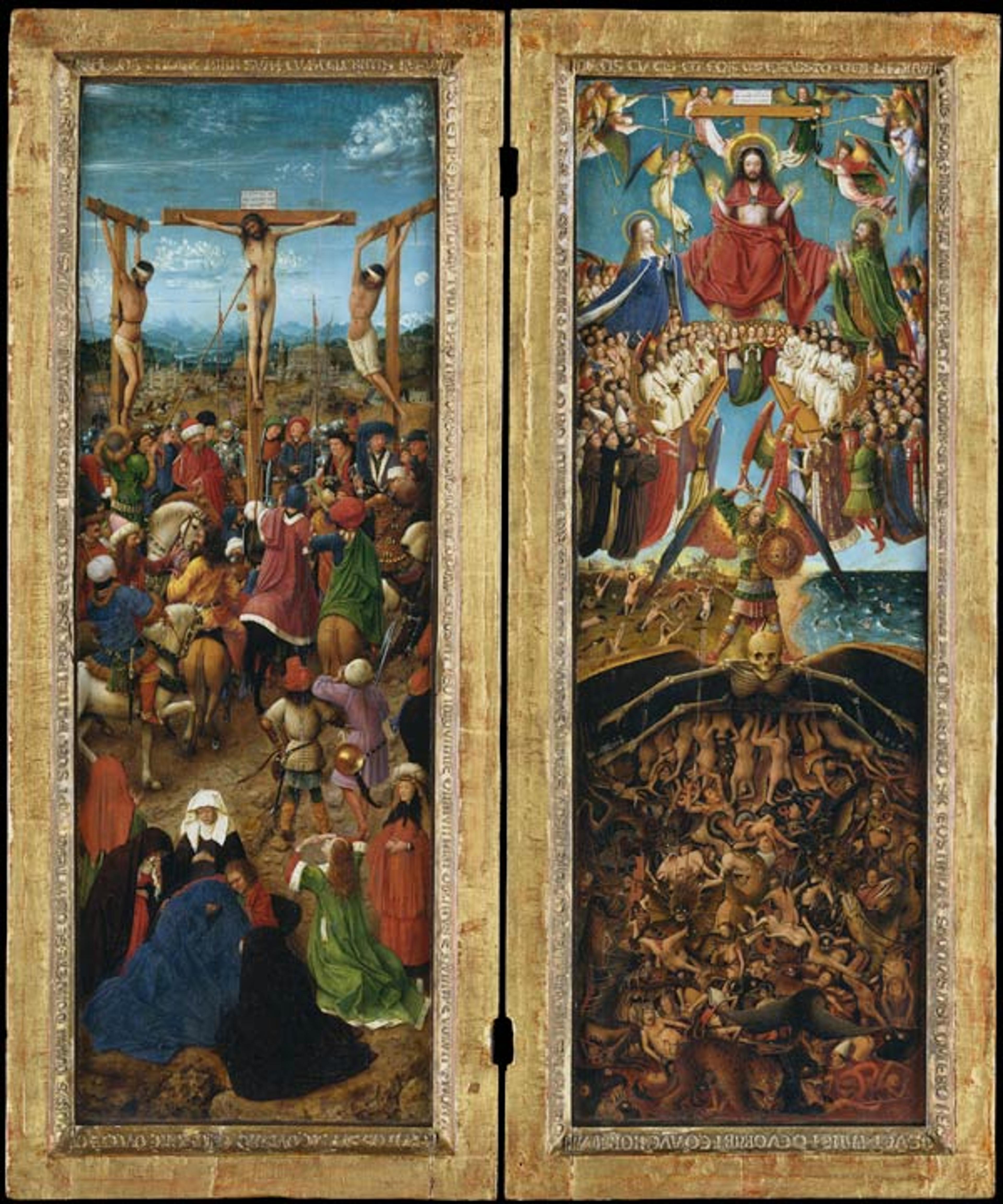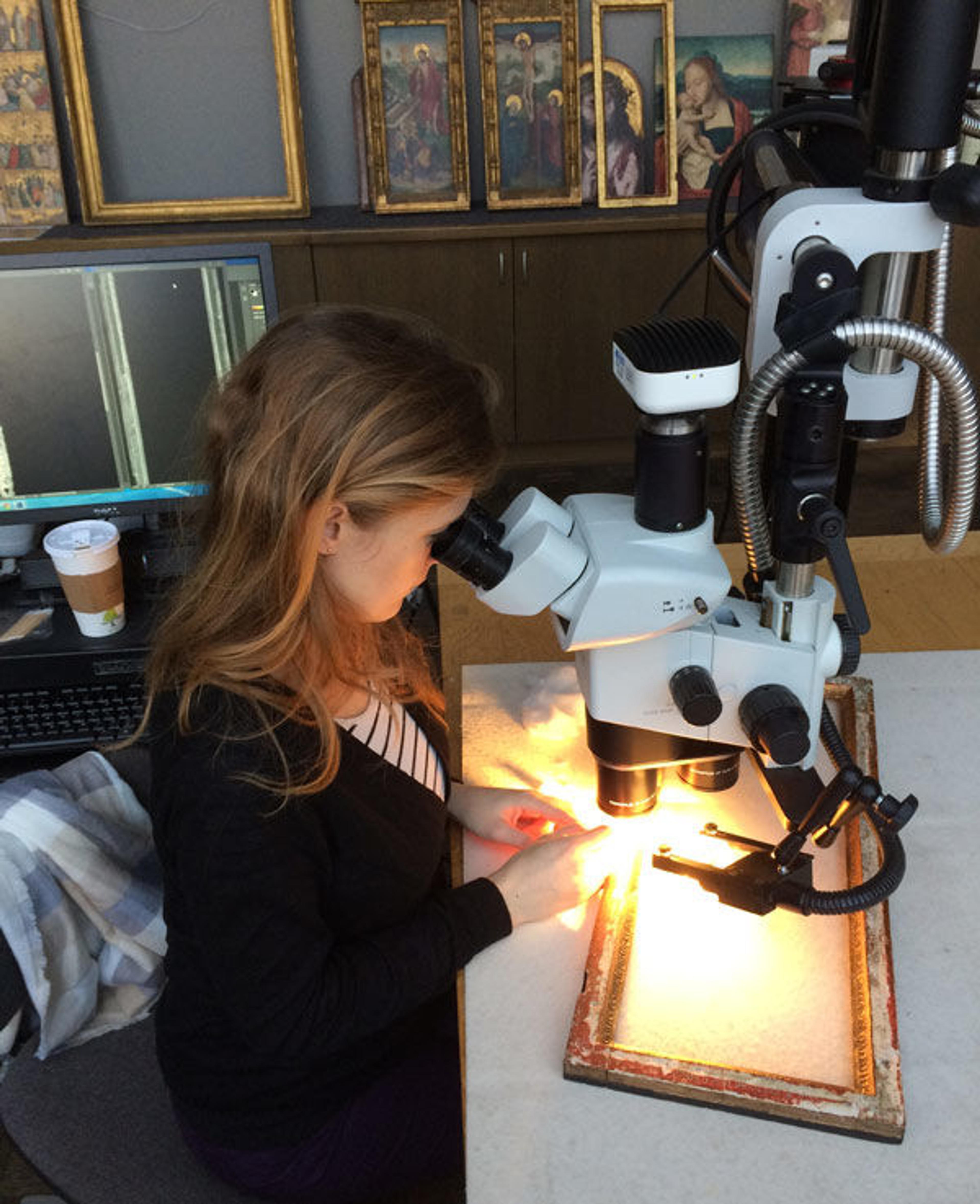Van Eyck's The Crucifixion; The Last Judgment: Rethinking a Masterwork

Jan van Eyck (Netherlandish, ca. 1390–1441) and Workshop Assistant. The Crucifixion; The Last Judgment, ca. 1440–41. Oil on canvas, transferred from wood; Each 22 1/4 x 7 2/3 in. (56.5 x 19.7 cm). The Metropolitan Museum of Art, New York, Fletcher Fund, 1933 (33.92ab)
«The past as fixed in amber? Nothing more to learn about an artwork? Nonsense! Digging deeper into the history of a work of art depends on the questions one asks and the ways in which scholars use the investigatory tools at their disposal.
On January 25, the Department of European Paintings let everyone in on one of the most fascinating and unexpected reassessments I can think of, relating to one of the Met's most prestigious masterpieces: Jan van Eyck's "diptych" (but was it a diptych?) of the Crucifixion and Last Judgment, which is on view through April 24 in the exhibition A New Look at a Van Eyck Masterpiece.»

Conservation Research Scholar Sophie Scully removes gilding added to the artwork's frame in the nineteenth century. Photograph by the author
To think this all began with an examination of the frame. Above, Conservation Research Scholar Sophie Scully works with the aid of a microscope as she removes the modern gilding that, since the nineteenth century, has hidden a fragmentary inscription related to the subjects of the two pictures that was carefully lettered on a red background.
Probing deeper into this painting is a project that involves people from many different disciplines, all working together to achieve a deeper understanding of the origin, initial appearance, and meaning of this amazing work. A New Look at a Van Eyck Masterpiece shows where we are now in the process—for this is a work in progress. Among the recent findings on display in the exhibition is a newly identified drawing from Rotterdam's Museum Boijmans Van Beuningen that relates directly to the Crucifixion painting.
Imagine—this is all taking place at the same time that one of the landmarks of European painting, the Ghent Altarpiece (located in Saint Bavo's Cathedral, Ghent), is being cleaned and examined, and the VERONA Project is investigating all of the Van Eyck paintings held in European collections. We thought the time had come to accompany our exhibition with an event that will enable everyone to find out where we are in our understanding of this extraordinary master: a Sunday at the Met program, Rethinking Jan van Eyck: Discoveries from New Technical Investigations of His Paintings, on April 17. Join us then to learn more!
Related Links
A New Look at a Van Eyck Masterpiece, on view January 25–April 24, 2016
82nd and Fifth: Noise by Maryan W. Ainsworth
Related Event
Sunday at the Met
Rethinking Jan van Eyck: Discoveries from New Technical Investigations of His Paintings
April 17, 2016, 3:00–4:30 p.m.
The Grace Rainey Rogers Auditorium
Maryan Ainsworth
Curator Emerita Maryan Ainsworth received her BA and MA in Art History from Oberlin College and her PhD from Yale University. A Museum staff member since 1977, she has specialized in the technical examination of paintings, initially in the Department of Paintings Conservation and subsequently as curator in European Paintings. Her publications and exhibitions include monographic studies on Bouts, Christus, David, Gossart, and Coecke van Alest, as well as the Met's early German paintings. Maryan is an adjunct professor at Barnard College, and she has been awarded the titles of Chevalier de l'Ordre de la Couronne (2001) and Chevalier de l'Ordre de Léopold (2011), bestowed by King Albert II of Belgium.
Keith Christiansen
Keith Christiansen, John Pope-Hennessy Chairman of the Department of European Paintings, began work at the Met in 1977, and during that time he has organized numerous exhibitions ranging in subject from painting in fifteenth-century Siena, Andrea Mantegna, and the Renaissance portrait, to Giambattista Tiepolo, El Greco, Caravaggio, Ribera, and Nicolas Poussin. He has written widely on Italian painting and is the recipient of several awards. Keith has also taught at Columbia University and New York University's Institute of Fine Art. Raised in Seattle, Washington, and Concord, California, he attended the University of California campuses at Santa Cruz and Los Angeles, and received his PhD from Harvard University.